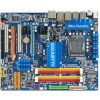- Qualcomm Launches Snapdragon 4 Gen 2 Mobile Platform
- AMD Launches Ryzen PRO 7000 Series Mobile & Desktop Platform
- Intel Launches Sleek Single-Slot Arc Pro A60 Workstation Graphics Card
- NVIDIA Announces Latest Ada Lovelace Additions: GeForce RTX 4060 Ti & RTX 4060
- Maxon Redshift With AMD Radeon GPU Rendering Support Now Available
Gigabyte EP45-UD3P

Looking to build a new machine on a budget? Then look no further than choosing Gigabyte’s EP45-UD3P as your choice for motherboard. It may not offer a lot in the area of bling, but it includes a solid design, lots of connectivity (including 8 USB and S-ATA), fantastic overclocking potential and best of all, it comes in at an average price of $115.
Page 8 – Overclocking the EP45-UD3P
Before tackling our overclocking results, let’s first clear up what we consider to be a real overclock and how we go about achieving it. If you regularly read our processor reviews, you may already be aware that I personally don’t care for an unstable overclock. It might look good on paper, but if it’s not stable, then it won’t be used. Very few people purchase a new piece of equipment for the sole purpose of finding the maximum overclock, which is why we focus on finding what’s stable and usable.
To help find the maximum stable overclock on any given motherboard, we focus on sticking to the simpler voltages, such as the ones for the Northbridge and CPU, and also the DIMM if it’s required. We try to work within safe limits, because anything too high is going to only kill your hardware faster. Luckily, all computer components nowadays are designed to handle some abuse, so you never need a lot of voltage to get anywhere.
The front-side-bus is what’s important on a motherboard, so that’s where we keep our focus. Because the FSB overclock can vary widely between a Quad-Core and Dual-Core (it’s much easier to achieve a higher OC on a Dual-Core), we test using both the QX9770 and E8400 to see how far we can get. Also, because our 4GB memory kit of choice isn’t that overclockable, we revert to a 2GB kit for the Dual-Core testing in order to achieve much a much higher FSB frequency.
Overclocking Gigabyte’s EP45-UD3P
First and foremost, I’ll say that overclocking this board wasn’t the most enjoyable of experiences. I found a lot of simple settings that should have been stable, weren’t, and the overall navigation of the tweaking section was finicky – it didn’t refresh fast enough and made scrolling up and down a chore. The good thing is that’s the worst of it, and the potential of the board is good.
Due to time-constraints, I wasn’t able to spend as much time with overclocking as I would have liked, and had to omit testing with a Dual-Core processor. However, I’d expect the results there to be quite similar to what we saw with the EP45-EXTREME, although maybe not as high. With our Quad-Core though, we hit an impressive 490MHz… just 10MHz shy of what we accomplished on the EP45-EXTREME. This was accomplished with 1.4v to the CPU and 1.59v to the Northbridge.

I sound like a broken record, but when picking up a motherboard that costs a mere $130 (without some sort of e-tailer discount), you don’t normally expect to see such incredible overclocking headroom. Again, due to time, I wasn’t able to stress the Quad-Core for the eight-hours I normally do, but I did two, and that’s enough to prove to me that it’s capable of handling some pain. To think, this was done using a six-phase power solution… who exactly needs one of those fancy 12 – 16 phases?
Support our efforts! With ad revenue at an all-time low for written websites, we're relying more than ever on reader support to help us continue putting so much effort into this type of content. You can support us by becoming a Patron, or by using our Amazon shopping affiliate links listed through our articles. Thanks for your support!





